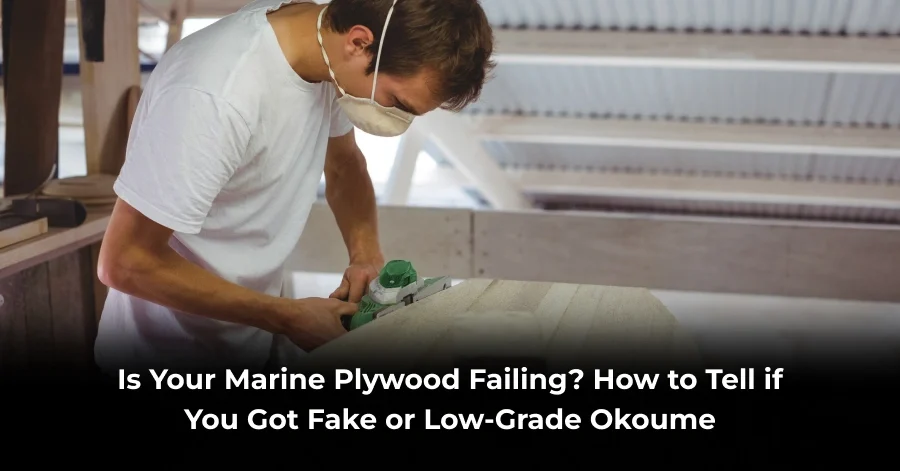You’ve poured your heart, soul, and a significant chunk of your budget into your dream boat, a custom van conversion, or a stunning piece of outdoor furniture. You did your research. You knew that for a project demanding resilience against moisture, the gold standard was a specific material: Okoume marine plywood. Renowned for its light weight, smooth surface, and excellent stability, it’s the go-to choice for builders who refuse to compromise.
But now, you’re seeing the dreaded signs. The edges are swelling like a sponge. Delamination—those sinister splits between the layers—is starting to appear. A surface you painstakingly planned to finish with a glossy coat of paint is now puckered and rough. The thought creeps in: “Did I get duped?”
Unfortunately, in the world of specialized lumber, the market is flooded with products that masquerade as the real deal. Getting stuck with fake or low-grade Okoume plywood can turn your labor of love into a costly, frustrating nightmare. This guide is your ally. We’ll walk you through how to spot the imposters, understand what true quality looks like, and ensure your next purchase from a woodworking supplies store is the real, resilient deal that will last for decades.
Why Okoume is King (And Why Fakers Love to Imitate It)
First, let’s understand what we’re looking for. Genuine Okoume marine plywood (often sold under the brand name “Gaboon Plywood”) comes from the Okoume tree (Aucoumea klaineana) in West Africa. It’s not naturally rot-resistant like Teak, but its magic lies in its construction. True marine-grade plywood, regardless of species, is defined by its structure:
- Void-Free Core: The inner plies are solid, with no gaps or voids. This prevents water from being trapped inside, which leads to rot and delamination.
- High-Quality, Waterproof Glue: It uses phenolic or melamine formaldehyde glues that can withstand prolonged immersion in water.
- Face and Back Veneers: These are sanded smooth and free of major defects, allowing for a beautiful finish.
Okoume plywood is prized because it executes this formula while being exceptionally lightweight and easy to work with. This premium reputation and price point make it a prime target for counterfeiters and less scrupulous manufacturers. They sell “Okoume-faced” panels or simply stamp a lower-grade plywood with a misleading “Marine” label.
The Telltale Signs Your “Marine Plywood” is a Fake
Before you even buy, you can save yourself a world of hurt by knowing what to look for. Don’t just trust the sticker; trust your eyes and hands.
- The Price is Suspiciously Low
This is the biggest red flag. High-quality Okoume marine plywood is a premium product. The process of harvesting, rotary-slicing into thin veneers, and pressing with expensive, waterproof resin is costly. If the price seems too good to be true, it almost always is. A genuine sheet will command a higher price than standard pine or fir plywood. A reputable woodworking supplies store will be transparent about why their product costs what it does. - Inspect the Edges: The Story is in the Layers
This is the single most important diagnostic step. Take a sheet and look directly at its edge.
- The Real Deal: You will see tightly packed, uniform layers (plies) of light-colored wood. The lines between them are thin and consistent. There are no dark patches or gaps.
- The Imposter: You will see obvious voids—black, gaping holes between the layers. You might even see patches of a much darker, different wood species used to fill the core. This is a sure sign of a low-grade interior plywood that has no business being near water.
- Knock on It (Seriously)
Tap the surface of the plywood with your knuckles. Genuine, void-free Okoume plywood will produce a solid, consistent sound across the entire sheet. A sheet with internal voids will have a hollow, dead-sounding spot when you tap over a gap. It’s a simple but surprisingly effective test. - Examine the Face Veneer
Authentic Okoume marine plywood has a very consistent, pale pinkish-brown hue with a subtle, often interlocked grain. The surface is sanded smooth.
- Low-Grade Signs:
-
- Excessive Patches: While some small, tight knots are permitted in the B-grade face, an abundance of large, football-shaped patches is a sign of a lower-quality veneer.
- “Okoume-Faced” Trick: The face might be a thin slice of Okoume, but the core layers are a different, heavier, and inferior species. Check the edge to confirm.
- Rough Sanding: A rough, fuzzy surface indicates poor manufacturing and will soak up excessive amounts of expensive epoxy and paint.
- The Stamp of (Mis)Approval
Look for the grading stamp. It should clearly state “Marine Grade” and often reference a standard like BS 1088 (British Standard) or its equivalents. Be wary of vague terms like “Marine Type” or “Boats & Docks.” These are marketing terms, not performance guarantees. A trustworthy supplier, like a dedicated woodworking supplies store, will provide clear documentation on the product’s specifications.
The Heartbreak of a Failed Project: More Than Just Money
Using a substandard panel might save you a few dollars upfront, but the long-term cost is immense.
- Structural Failure: In a boat hull or deck, delamination isn’t just an aesthetic issue; it’s a critical safety hazard.
- Financial Drain: You’ll waste far more on epoxy, fairing compounds, and paint trying to seal a poor-quality substrate. The ultimate cost? Tearing out and replacing the entire panel.
- Wasted Time and Passion: This is the real killer. The hundreds of hours of meticulous work are rendered worthless, leading to frustration and disillusionment.
This is why your choice of supplier is as important as your choice of material. Buying from a big-box store that doesn’t specialize in marine applications is a huge gamble. Instead, seek out a specialist woodworking supplies store that understands the critical differences and stakes involved.
Your Blueprint for Buying the Real Deal
So, how do you ensure you’re getting authentic, high-grade material?
- Buy from a Specialist: Don’t buy your Okoume marine plywood from a store that also sells garden hoses and power tools. Go to a dedicated lumberyard or a woodworking supplies store that caters to boat builders, fine furniture makers, and serious craftspeople. The staff will be knowledgeable and can answer technical questions.
- Ask the Right Questions: “Is this BS 1088 certified?” “Are the cores 100% Okoume and void-free?” “Can I inspect the edges before I buy?” A confident “yes” is what you’re listening for.
- Physically Inspect Before Payment: Never assume. When you go to pick it up, do the edge inspection and the knock test. A good supplier will encourage this.
- Understand the Grades: Marine-grade Okoume plywood comes in different face grades (like A-A, A-B). Know which level of cosmetic perfection your project requires.
Also Read: How to Finish Okoume Plywood: A Step-by-Step Guide for Maximum Protection
AEW Woods: Your Trusted Source for Authentic Materials
In a market saturated with uncertainty, finding a supplier you can trust is half the battle won. This is where companies like AEW Woods shine. For decades, AEW Woods has established itself as a premier importer and distributor of the finest specialty lumber and plywood. They are not just a warehouse; they are curators of quality.
When you source your Okoume plywood from AEW Woods, you are buying with confidence. They understand the critical importance of integrity in materials. The Okoume marine plywood they supply meets the stringent requirements that discerning craftsmen demand. Their expertise ensures that the product you receive is precisely what is advertised on the label, saving you from the heartache of project failure. For anyone serious about their craft, partnering with a knowledgeable supplier like AEW Woods is the most important step in the building process.
Conclusion
Your project deserves a foundation that matches your vision and effort. The allure of a cheaper sheet of plywood can be strong, but as countless builders have learned the hard way, the initial savings are a fool’s bargain. True Okoume marine plywood is an investment in the longevity, safety, and beauty of your creation.
By learning to identify the signs of fake or low-grade panels—the suspicious price, the telltale voids in the edges, the hollow sound—you empower yourself as a builder. You transform from a potential victim of misleading marketing into an informed craftsman. Ultimately, your greatest tool is not just in your workshop; it’s the knowledge in your head and the relationship you build with a trusted woodworking supplies store. By choosing quality, and partners like AEW Woods who champion it, you ensure that your masterpiece remains a source of pride, not regret, for years to come.
Frequently Asked Questions (FAQs)
- What’s the difference between “Marine Grade” and “Exterior Grade” plywood?
Exterior grade plywood uses waterproof glue but allows for voids and knots in the inner plies. It’s fine for outdoor siding or soffits but not for constant immersion or critical structural applications. True marine grade is entirely void-free and uses higher-quality veneers, making it suitable for boat building. - I’m on a tight budget. Is there a legitimate alternative to Okoume marine plywood?
For non-structural applications or projects that won’t be permanently exposed to water (like interior furniture or van build cabinetry), a high-quality, void-free birch plywood can be a good, strong alternative. However, it is significantly heavier. For any marine application, it’s best not to compromise on the core material. - Can I make low-grade plywood waterproof with epoxy?
Epoxy is an excellent sealer, but it is not a miracle worker. It can prevent water from entering from the surface, but it cannot stop the inherent movement and degradation of a poor-quality core. A void-filled panel can still trap moisture from the edges, leading to internal rot that you can’t see until it’s too late. Always start with the best substrate you can afford. - How should I store my Okoume plywood before I use it?
Store it in a dry, flat, and climate-controlled space. Keep it off the concrete floor (use stickers) and protect it from direct sunlight and rain. If you’re storing it long-term, consider wrapping it in a breathable fabric or plastic with gaps to prevent condensation. - My local woodworking supplies store doesn’t carry it. Can I order Okoume plywood online?
Yes, many reputable specialists, including AEW Woods, sell and ship high-quality Okoume marine plywood directly to customers. The advantage is guaranteed quality; the disadvantage is the inability to hand-pick each sheet, though trusted suppliers will have strict quality control.






